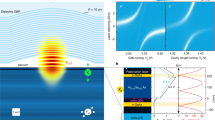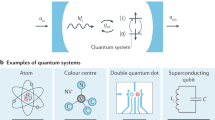Abstract
Solid-state cavity quantum electrodynamics (QED) systems offer a robust and scalable platform for quantum optics experiments and the development of quantum information processing devices. In particular, systems based on photonic crystal nanocavities and semiconductor quantum dots have seen rapid progress. Recent experiments have allowed the observation of weak1 and strong coupling2,3 regimes of interaction between the photonic crystal cavity and a single quantum dot in photoluminescence. In the weak coupling regime1, the quantum dot radiative lifetime is modified; in the strong coupling regime3, the coupled quantum dot also modifies the cavity spectrum. Several proposals for scalable quantum information networks and quantum computation rely on direct probing of the cavity–quantum dot coupling, by means of resonant light scattering from strongly or weakly coupled quantum dots4,5,6,7,8,9. Such experiments have recently been performed in atomic systems10,11,12 and superconducting circuit QED systems13, but not in solid-state quantum dot–cavity QED systems. Here we present experimental evidence that this interaction can be probed in solid-state systems, and show that, as expected from theory, the quantum dot strongly modifies the cavity transmission and reflection spectra. We show that when the quantum dot is coupled to the cavity, photons that are resonant with its transition are prohibited from entering the cavity. We observe this effect as the quantum dot is tuned through the cavity and the coupling strength between them changes. At high intensity of the probe beam, we observe rapid saturation of the transmission dip. These measurements provide both a method for probing the cavity–quantum dot system and a step towards the realization of quantum devices based on coherent light scattering and large optical nonlinearities from quantum dots in photonic crystal cavities.
This is a preview of subscription content, access via your institution
Access options
Subscribe to this journal
Receive 51 print issues and online access
$199.00 per year
only $3.90 per issue
Buy this article
- Purchase on Springer Link
- Instant access to full article PDF
Prices may be subject to local taxes which are calculated during checkout




Similar content being viewed by others
References
Englund, D. et al. Controlling the spontaneous emission rate of single quantum dots in a two-dimensional photonic crystal. Phys. Rev. Lett. 95, 013904 (2005)
Yoshie, T. et al. Vacuum Rabi splitting with a single quantum dot in a photonic crystal nanocavity. Nature 432, 200–203 (2004)
Hennessy, K. et al. Quantum nature of a strongly coupled single quantum dot-cavity system. Nature 445, 896–899 (2007)
Cirac, J. I., Zoller, P., Kimble, H. J. & Mabuchi, H. Quantum state transfer and entanglement distribution among distant nodes in a quantum network. Phys. Rev. Lett. 78, 3221–3224 (1997)
Imamoglu, A. et al. Quantum information processing using quantum dot spins and cavity QED. Phys. Rev. Lett. 83, 4204–4207 (1999)
Duan, L. M. & Kimble, H. J. Scalable photonic quantum computation through cavity-assisted interactions. Phys. Rev. Lett. 92, 127902 (2004)
Childress, L., Taylor, J. M., Sorensen, A. S. & Lukin, M. D. Fault-tolerant quantum repeaters with minimal physical resources and implementations based on single-photon emitters. Phys. Rev. A 72, 052330 (2005)
Waks, E. & Vučković, J. Dipole induced transparency in drop-filter cavity-waveguide systems. Phys. Rev. Lett. 96, 153601 (2006)
Ladd, T. D., van Loock, P. K., Nemoto, K., Munro, W. J. & Yamamoto, Y. Hybrid quantum repeater based on dispersive CQED interactions between matter qubits and bright coherent light. N. J. Phys. 8, 184 (2006)
Birnbaum, K. M. et al. Photon blockade in an optical cavity with one trapped atom. Nature 436, 87–90 (2005)
Rauschenbeutel, A. et al. Coherent operation of a tunable quantum phase gate in cavity QED. Phys. Rev. Lett. 83, 5166–5169 (1999)
Nogues, G. et al. Seeing a single photon without destroying it. Nature 400, 239–242 (1999)
Schuster, D. I. et al. Resolving photon number states in a superconducting circuit. Nature 445, 515–518 (2007)
Kimble, H. J. in Cavity Quantum Electrodynamics (ed. Berman, P.) 213–219 (Academic, San Diego, 1994)
Akahane, Y., Asano, T., Song, B.-S. & Noda, S. High-Q photonic nanocavity in a two-dimensional photonic crystal. Nature 425, 944–947 (2003)
Faraon, A. et al. Local quantum dot tuning on photonic crystal chips. Appl. Phys. Lett. 90, 213110 (2007)
Gerardot, B. D. et al. Contrast in transmission spectroscopy of a single quantum dot. Appl. Phys. Lett. 90, 221106 (2007)
Tan, S. M. A computational toolbox for quantum and atomic physics. J. Opt. B 1, 424–432 (1999)
Hood, C. J., Chapman, M. S., Lynn, T. W. & Kimble, H. J. Real-time cavity QED with single atoms. Phys. Rev. Lett. 80, 4157–4160 (1998)
Auffeves-Garnier, A., Simon, C., Gerard, J. M. & Poizat, J.-P. Giant optical nonlinearity induced by a single two-level system interacting with a cavity in the Purcell regime. Phys. Rev. A 75, 053823 (2007)
Englund, D., Faraon, A., Zhang, B., Yamamoto, Y. & Vučković, J. Generation and transfer of single photons on a photonic crystal chip. Opt. Express 15, 5550–5558 (2007)
Faraon, A., Waks, E., Englund, D., Fushman, I. & Vučković, J. Efficient photonic crystal cavity-waveguide couplers. Appl. Phys. Lett. 90, 073102 (2007)
Reiner, J. E., Smith, W. P., Orozco, L. A., Carmichael, H. J. & Rice, P. R. Time evolution and squeezing of the field amplitude in cavity QED. J. Opt. Soc. Am. B 18, 1911–1921 (2001)
Imoto, N., Haus, H. A. & Yamamoto, Y. Quantum nondemolition measurement of the photon number via the optical Kerr effect. Phys. Rev. A 32, 2287–2292 (1985)
Vučković, J., Englund, D., Fattal, D., Waks, E. & Yamamoto, Y. Generation and manipulation of nonclassical light using photonic crystals. Physica E 32, 466–470 (2006)
Acknowledgements
Financial support was provided by the ONR Young Investigator Award, the MURI Center for photonic quantum information systems (ARO/DTO Program), the Okawa Foundation Faculty Research Grant, and the CIS Seed fund. D.E. and I.F. were also supported by the NDSEG fellowship. Work was performed in part at the Stanford Nanofabrication Facility of NNIN supported by the National Science Foundation.
Author information
Authors and Affiliations
Corresponding author
Rights and permissions
About this article
Cite this article
Englund, D., Faraon, A., Fushman, I. et al. Controlling cavity reflectivity with a single quantum dot. Nature 450, 857–861 (2007). https://doi.org/10.1038/nature06234
Received:
Accepted:
Issue Date:
DOI: https://doi.org/10.1038/nature06234
This article is cited by
-
Strong coupling of hybrid states of light and matter in cavity-coupled quantum dot solids
Scientific Reports (2023)
-
High quality factor metasurfaces for two-dimensional wavefront manipulation
Nature Communications (2023)
-
Many-body cavity quantum electrodynamics with driven inhomogeneous emitters
Nature (2023)
-
Physics-informed recurrent neural network for time dynamics in optical resonances
Nature Computational Science (2022)
-
On-chip generation and dynamic piezo-optomechanical rotation of single photons
Nature Communications (2022)
Comments
By submitting a comment you agree to abide by our Terms and Community Guidelines. If you find something abusive or that does not comply with our terms or guidelines please flag it as inappropriate.



